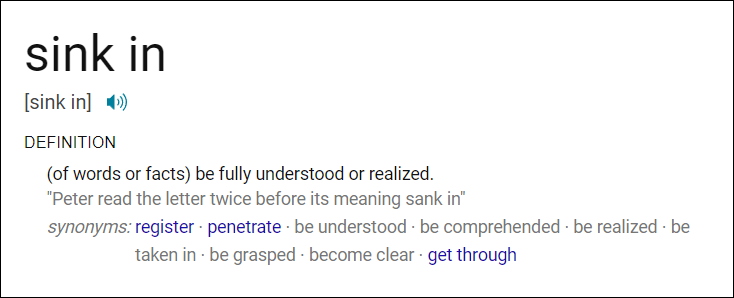It was around 2017 when there was much talk and usage about letting things ‘sink in’ — primarily via textual communication. Social media platforms like Reddit, Twitter, Instagram, and Facebook had a gradual but steady increase in the number of ‘let that sink in’ memes, posts, and content, overall.
Despite being around for quite a while, the expressive phrase saw its first Urban Dictionary entry only in 2020. So, have we been sinking things in for just about the last three to four years, or has this phrase been in our vocabulary for much longer? Also, what does this strange phrase mean? Is there more to it than meets its literal meaning?
What Does this Memed ‘sink in’ Expression Mean?

When we say or see the phrase ‘let that sink in’, it’s only human to understand it in its immediate sense — sinking. ‘Sink’ for all we know means drown, succumb to the waters, and essentially, go below any surface — water or anything that’s penetrable. Besides, ‘sink’ is also a kitchen/bathroom fixture. This explains the expression’s reserve of plumber jokes, memes, and puns. After all, we’re letting it sink in, geddit?
Jokes, memes, and literal meaning aside, ‘sink’ also has another meaning — a figurative definition. The non-literal interpretation of ‘sink’ isn’t very different from its literal essence. As an idiom, ‘let that sink in’ signifies allowing oneself to absorb, understand, comprehend, and ponder over something. Here too, ‘sink’ means penetrate, but with a philosophical tangent that denotes influence, impression, and impact.
‘Let that sink in’ is a powerful statement that informs someone to stop and allow something to work on them. It is mostly used to change perspective, bring in more understanding, expand limited prior knowledge, and hopefully result in a positive future thought about something. ‘Sink’ works the same way non-literally as it does literally, with only a subjective difference of thought, perception, and understanding.
How Old is ‘Let that Sink in’, Anyway?
Since ‘let that sink in’ became a popular meme in recent years, we could mistake it for a novel product of the internet. But here’s something shocking. It is plausible that this expression has not just been around for decades but probably even centuries or millennia. So, how old is it anyway?
Some records inform that the phrase can be as old as 1300 AD. These unvalidated sources point to a reference of the expression in the Latin poem – Cursor Mundi. ‘Let that sink in’ is also said to have appeared in the Middle English Dictionary in the 1400s.
There are speculations about quite a few mentions of the phrase between the 14th and 19th centuries. Some are backed by reliable and traceable evidence, but most use cases don’t have enough grounds to prove their usage due to lack of or loss in translation. Each version of the phrase referred to different parts of the body — heart, mind, and ears. But, ‘let that sink in’ was a common occurrence throughout.
Possible genesis of the expression
There seems to be a dependable incidence of the phrase’s usage towards the end of the 18th century. In the book, ‘The Ruin of Rome’, the following line introduces an ancient version of the present-day idiom —
‘Not only to receive this as truth, but feeing it is concerning a truth, as our Lord faith, Luke ix. 44. “Let thefe thinks fink in your hearts:” fo we fay, let this truth fink in your hearts.‘
The essential part of the passage containing the phrase translates to “Let these things sink in your heart”. Given that this was the use-case and that it’s possibly the first mention of the phrase (so far), it can be the original and longer version of ‘Let this sink in’.
The modern version of the idiomatic phrase accelerated during and post the 19th century. There were many more mentions during this time frame. However, like every catchphrase that loses its luster after a while, ‘let that sink in’, figuratively sank for a bit and stayed afloat before reviving momentum in 2018. Though it started as a ridiculous plumbing pun or a meme, the phrase is active on the internet, humorously or otherwise.
How to Use ‘Let that Sink in’?
What’s a "Let that sink in" fun fact? from AskReddit
Embedded JavaScript
Firstly, you don’t need a viral meme idea to use this famous expression on social media. Before being a meme, it’s quite an impactful phrase that makes someone think and go beyond direct and literal thinking. It elicits someone to go back to something and spend a couple of extra moments to grasp the context to its fullness correctly.
So, any framework, textual, virtual, or in-person, that requires re-emphasis or extra attention can use this magical phrase. Here are a couple of mainstream contexts where ‘let that sink in’ can do wonders.
To make another think like you
It’s human nature to try consuming content when we’re directed to do so in a certain way. Adding ‘let that sink in’ has a good chance the reader will view things and maybe even think about something in the same way as intended.
When you say ‘let that sink in’, there’s a moment of empathy, understanding beyond reading, and profound focus and analysis that you’re passing onto an audience via your content or in-person speech — and inspiring them to do or feel the same.
For example, ‘We have less than 12 years to set the climate right. That’s just about another 10 years or so. Let that sink in’ or ‘My strict mom encouraged me to go for a night out. ENCOURAGED ME. Let that sink in, mate. It hasn’t sunk in me yet!’.
Stress, at times, is a good thing
Contextual stress in written or in-person content is a great way to encourage memory retention in listeners. When we say the same thing in more than a single way and more than a single time, it stays with a good listener. This is a redundant use-case if your listeners are distracted. ‘Let that sink in’ is one of the best ways to stress something.
For instance, ‘We have three extra working hours to cover tomorrow. Three extra hours. Let that sink in’, ‘NO Covid restrictions starting TONIGHT. Let that sink in’, ‘War doesn’t just destroy humans, it destroys everything. Even the unaffected. Let that sink in’.
When they must hold onto a thought
When we ask someone to hold onto a thought, we’re usually reciprocating with a thought that straight-up opposes the dearly held thought or improvises on it. The reason we do this is to enable better reception so that the essence of a context is correctly and fully comprehended. So, while asking people to hold onto a thought, use ‘let that sink in’.
- What day is today?
Uhhh. Tuesday?
What is Tomorrow?
Dude.
Come on. What is tomorrow?
Wednesday, man. Stop it.
It’s just a Wednesday, ain’t it?
JESUS. YES.
OK. Let that sink in, then.
What? That it’s a Wednesday?!
Dude. It’s your birthday. What a di… - The current currency will not hold the same value the next year.
Yeah, I know that.
Let that sink in
And?
Very soon your present pay will be worth just half of what it is.
Why do you always do this?
Start a laughter riot
Many of us are guilty of not getting a joke on the first attempt. And that’s okay. There’s nothing wrong with us nor there is with being a little late to humor. We only miss out on the timing, and with that, the punch the joke was capable of.
Sometimes, people don’t get our jokes immediately. To better an awkward gap of silence between telling the joke and waiting for a cackle, ‘let it/that sink in’ can be a wonderful bridge — one that may even make the situation funnier!
- Okay. Here’s another miserable dark joke
Do tell.
So, Stephen Hawking walks into a bar, and..
And?
Let that sink in.
What? OH. OH MY GOD. YOU’RE HORRIBLE. - … and I told her that I’ve been here longer
Okay, so like, the chicken came first?
What?
Give it a moment. Let that sink in
*approx. 45 mins later*
That was a pretty pathetic joke. And I love it.
While stating facts
One of the most used angles for this phrase is from the truth. Many times, ‘let it sink in’ is applied while stating a fact that’s either unknown, forgotten, or simply overlooked. This use-case is the most effective as it stirs a brief but overwhelming moment of realization — and since it’s factual, it’s intellectual, interesting, and valuable.
This use-case holds slightly more weightage than the others — especially on the internet. Besides, when a fact is served with this phrase, it really sinks in, tends to stay longer in the reader’s memory, and sticks with them (example – the Reddit thread above).
Analysis
You not in love til u don’t wanna cheat.. let that sink in because y’all confused— OG 🥶💨 (@noony0g) March 8, 2022
Embedded JavaScript
From the mentioned and other alleged sources of the origin, it is possible that ‘let that sink in’ began with religious connotations. The former versions of the phrase like ‘let that sink into your heart’ or ‘let that sink into your mind’, usually had a religious context that the author/speaker was emphasizing with the expression. Besides, this phrase often occurred with an assertive tone about action that was to be taken by the reader/listener.
‘Let it sink in’ may be a shortened version, but it continues to have the same implication and understanding. Except now, it’s not necessary to mention the obvious as the context would be doing that job. If it’s an emotional context, then, the place where it would be sinking and resting is the emotional part of the brain which, figuratively, is the heart. And if it’s intellectual, then, it’s that part of our conscience.
But, why does ‘let that sink in’ have the effect that it does?
Before ‘let that sink in’ became a meme and an internet sensation, it was used to produce a sudden, euphoric moment of realization in the minds of the readers. Nevertheless, the internet’s use of the expression holds the same value and insight, and sometimes, with a comical tone.
The idiom weighs more into the word ‘sink’ in the expression. This is what causes instant and sometimes profound awareness and comprehension. Even if someone doesn’t fully understand the idiomatic tangent of the phrase, they will be able to relate the functionality of the word ‘sink’. This provokes readers to do a bit more thinking and relating than usual.
Another aspect of the ‘let that/it sink in’ expression, as mentioned previously, is empathy. When we tell someone a story and also inform them to ‘let it sink in’, we’re trying our best as storytellers to instill empathy and get readers or listeners into the shoes of the story. We want them to walk the story and understand it more deeply. ‘Let that sink in’ is one such expression that, more often than not, carries out and establishes this intention.
Conclusion
‘Let it sink in’ is a powerful expression, more than we can realize. It’s a boon to our dialect and for many reasons. The expression is capable of inducing empathetic thinking, understanding, and the ability to relate to a context.
Previously, the expression was a manner of instilling godliness and religious importance in the hearts and minds of followers and devotees. Today, ‘let it sink in’ is the modern way of getting people to go the extra mile — and think.










Member discussion